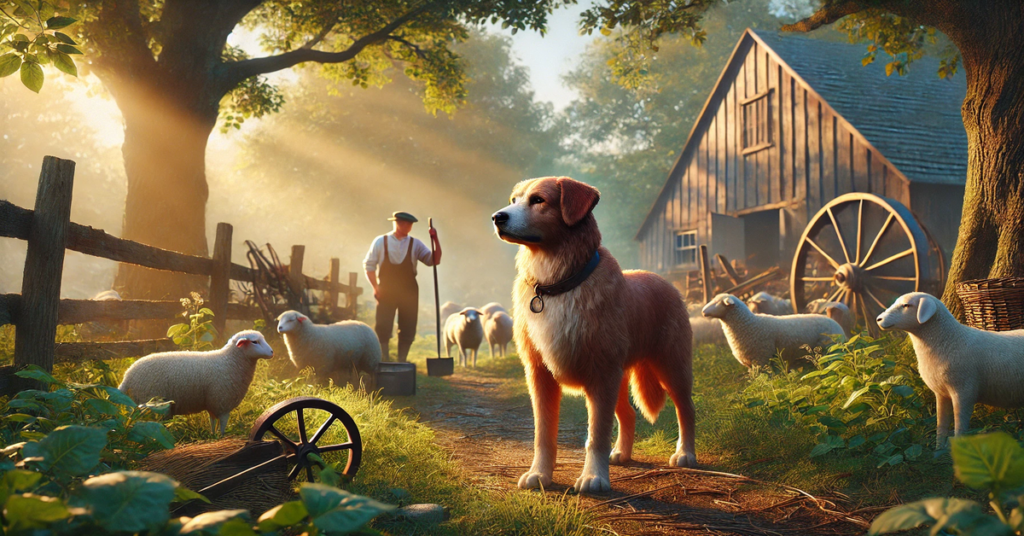Dogs have long held a special place in human society. Among the most admired roles they have taken on is that of the farmer’s companion. The “farmer’s dog” is not just a pet; it is a vital partner in agricultural life, playing diverse roles from protecting livestock to providing companionship. In this article, we delve into the multifaceted world of the farmer’s dog, exploring its history, roles, characteristics, and significance in rural and modern agricultural settings.
A Brief History of the Farmer’s Dog
Dogs have been integral to human life for thousands of years, with the domestication of wolves estimated to have occurred around 20,000 to 40,000 years ago. As agriculture developed approximately 10,000 years ago, the role of dogs shifted from hunting assistants to guardians and laborers.
The farmer’s dog emerged as a distinct entity during the agricultural revolution. These dogs were bred selectively for traits such as intelligence, loyalty, stamina, and agility. Early breeds like the Border Collie, Australian Shepherd, and Anatolian Shepherd were tailored to specific tasks—herding, guarding, and hunting pests—ensuring the safety and productivity of farms.
Roles and Responsibilities of the Farmer’s Dog
Farmer’s dogs perform a variety of tasks that support agricultural operations. Each role is critical to the smooth functioning of a farm:
1. Herding Livestock
One of the primary roles of a farmer’s dog is herding livestock. Breeds like the Border Collie and Australian Cattle Dog are particularly adept at this task. These dogs possess an innate ability to manage sheep, cattle, or goats, guiding them to pastures or corrals with precision and minimal human intervention.
2. Guarding Livestock
Livestock guardian dogs, such as the Great Pyrenees and Anatolian Shepherd, are tasked with protecting animals from predators like wolves, coyotes, and bears. Their imposing size, keen senses, and fierce loyalty make them ideal for this role.
3. Pest Control
Farms often struggle with pests such as rodents, which can damage crops and spread disease. Smaller breeds, like Jack Russell Terriers, excel in hunting and controlling these nuisances, ensuring a healthier farm environment.
4. Protecting the Homestead
In addition to safeguarding livestock, farmer’s dogs often protect the farm and its residents from intruders. Their barking serves as a deterrent, while their presence provides peace of mind.
5. Companionship
Farming can be isolating, and the farmer’s dog often becomes a trusted companion. These dogs provide emotional support and enrich the lives of their owners through their unwavering loyalty and affection.
6. Assisting with Daily Tasks
Some farmer’s dogs are trained to perform specific tasks, such as retrieving tools, opening gates, or helping injured or disabled farmers navigate the terrain. Their intelligence and eagerness to assist make them invaluable.
Characteristics of an Ideal Farmer’s Dog
The farmer’s dog is not a specific breed but rather a role fulfilled by various breeds or mixed-breed dogs possessing key traits. The following characteristics define an ideal farmer’s dog:
1. Intelligence
Farmer’s dogs must be quick learners capable of understanding commands and adapting to new situations. Breeds like the Border Collie are renowned for their high intelligence.
2. Stamina and Strength
Farm work demands a dog with ample energy and physical endurance. Dogs that lack stamina may struggle to keep up with the rigorous demands of farm life.
3. Loyalty
A strong bond between the farmer and the dog is essential for effective teamwork. Loyal dogs are more likely to protect the farm and its residents.
4. Trainability
A farmer’s dog must respond well to training, following commands accurately and reliably. Trainability ensures safety and efficiency in performing tasks.
5. Temperament
The ideal farmer’s dog has a balanced temperament, remaining calm under pressure yet alert to potential threats. Aggression is undesirable, as it can harm livestock or disrupt the farm’s harmony.
6. Protective Instincts
Dogs with strong protective instincts are better suited for guarding livestock and property. These instincts are particularly vital in areas prone to predators.
Popular Breeds of Farmer’s Dogs
While mixed breeds can excel in the role of a farmer’s dog, several purebred dogs are celebrated for their abilities:
1. Border Collie
Known for their intelligence and agility, Border Collies are often regarded as the ultimate herding dog. Their boundless energy and work ethic make them ideal for farms with extensive livestock.
2. Australian Shepherd
These versatile dogs are skilled at herding and guarding. They are highly trainable and thrive in active environments.
3. Great Pyrenees
This livestock guardian breed is known for its calm demeanor and protective instincts. Great Pyrenees are excellent at warding off predators while remaining gentle with livestock.
4. Jack Russell Terrier
Small but mighty, the Jack Russell Terrier is perfect for pest control. Their hunting instincts and energetic nature make them invaluable on farms.
5. Anatolian Shepherd
This breed is a formidable guardian with the strength and courage to protect livestock from large predators. They are particularly suited for farms in rugged terrains.
6. Corgi
Originally bred for herding cattle, Corgis are smaller herding dogs with remarkable agility and determination.
The Modern Farmer’s Dog
As agriculture evolves, so too does the role of the farmer’s dog. Modern technologies like electric fences and drones have reduced some traditional responsibilities, but these loyal companions remain indispensable. Today, farmer’s dogs often:
- Work alongside machinery, such as ATVs or tractors.
- Participate in search-and-rescue missions in rural areas.
- Serve as therapy dogs for farmers coping with stress or isolation.
Training a Farmer’s Dog
Proper training is critical for a farmer’s dog to perform its duties effectively. Here are key steps to training:
1. Early Socialization
Expose puppies to various environments, animals, and people to build confidence and adaptability.
2. Basic Obedience Training
Teach commands like sit, stay, come, and heel. Obedience forms the foundation for specialized training.
3. Task-Specific Training
Focus on the dog’s role, whether herding, guarding, or pest control. Use positive reinforcement techniques to encourage desired behaviors.
4. Consistency and Patience
Regular training sessions and consistent commands help reinforce learning. Patience is key, as some tasks may take time to master.
5. Collaboration with Experts
Consider consulting professional trainers or joining herding dog clubs for guidance and resources.
Challenges of Owning a Farmer’s Dog
While farmer’s dogs are indispensable, they come with challenges:
- High Energy Levels: Many breeds require significant exercise and mental stimulation to prevent boredom and destructive behavior.
- Specialized Care: Dogs working in extreme climates or rugged terrains may need extra care, such as paw protection or hydration.
- Time Investment: Training and maintaining a farmer’s dog demands considerable time and effort.
- Predator Conflicts: Guarding dogs may encounter dangerous predators, risking injury.
Conclusion
The farmer’s dog is a cornerstone of agricultural life, embodying loyalty, intelligence, and resilience. Whether herding sheep, guarding livestock, or simply being a steadfast companion, these dogs contribute immeasurably to the farming community. As agriculture continues to evolve, the adaptability and dedication of the farmer’s dog ensure its enduring relevance.
FAQs
1. What is the best breed for a farmer’s dog? The best breed depends on the farm’s needs. For herding, Border Collies are exceptional. For guarding livestock, Great Pyrenees or Anatolian Shepherds are ideal. Mixed breeds can also excel if they possess the required traits.
2. Can any dog be a farmer’s dog? Not all dogs are suited for farm life. Dogs with high energy, intelligence, and trainability are better candidates. Specific breeds are often chosen for their specialized abilities.
3. How much training does a farmer’s dog need? Training varies based on the dog’s role. Basic obedience training is essential, followed by task-specific training. Ongoing reinforcement and practice are necessary to maintain skills.
4. Do farmer’s dogs get along with livestock? Yes, with proper training and socialization, farmer’s dogs can coexist peacefully with livestock. Some breeds, like livestock guardian dogs, are bred specifically for this purpose.
5. How do farmer’s dogs handle predators? Livestock guardian dogs are particularly effective at deterring predators through their size, barking, and protective instincts. However, they may need training to manage confrontations safely.
6. Are farmer’s dogs suitable for non-farm environments? While they can adapt to non-farm settings, these dogs require ample exercise and mental stimulation. Prospective owners should be prepared to meet their physical and psychological needs.







